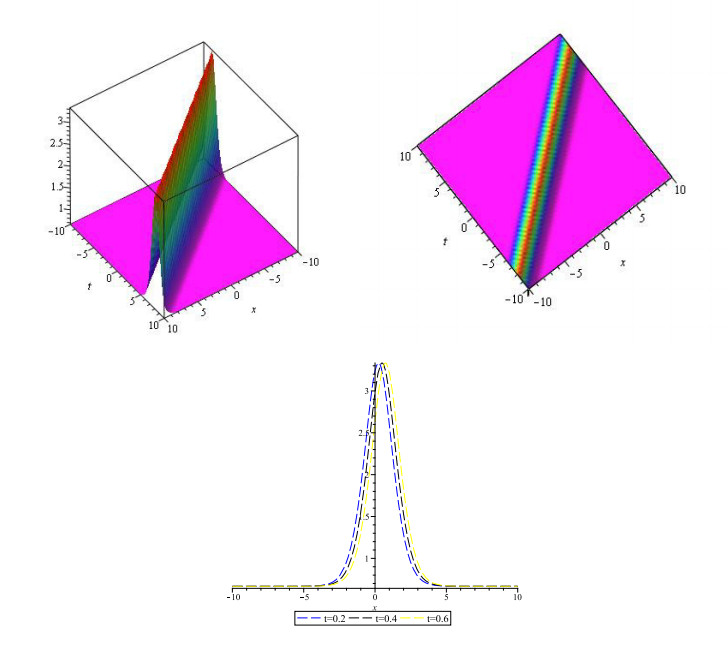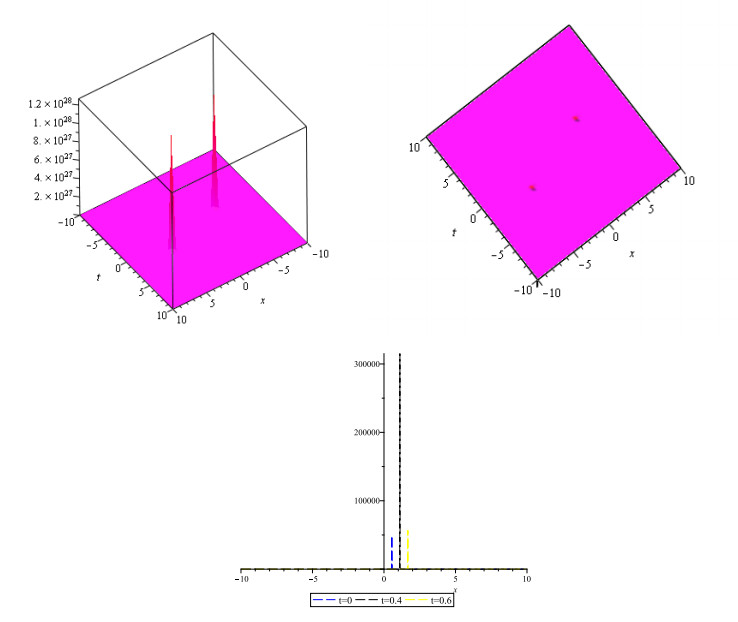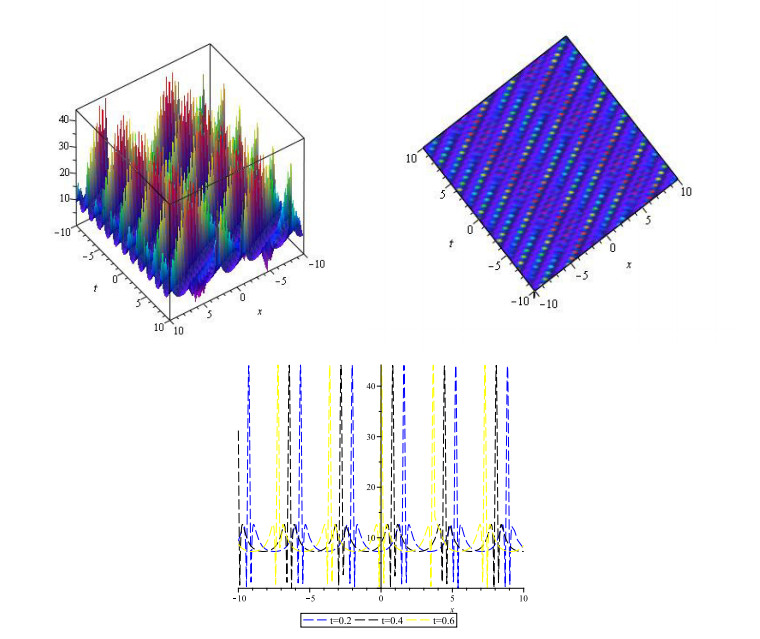We present new exact solutions for the (1+1)-dimensional Kaup-Kupershmidt (KK) equation by employing method of double (G′/G,1/G)-expansion. We express solutions by hyperbolic, trigonometric and rational functions explicitly. Computational results indicate the efficiency and applicability potential of the method.
1.
Introduction
Let I⊆R be an interval. Then a real-valued function h:I→R is said to be convex (concave) on the interval I if the inequality
holds for all κ1,κ2∈I and t∈[0,1].
It is well known that convexity (concavity) has wide applications in pure and applied mathematics [1,2,3,4,5,6,7,8,9,10,11,12]. The well known Hermite-Hadamard inequality [13,14,15,16,17,18,19,20] for the convex (concave) function h:I→R can be stated as follows:
for all κ1,κ2∈I with κ1≠κ2.
Recently, many generalizations, invariants and extensions have been made for the convexity, for example, harmonic-convexity [21,22], exponential-convexity [23,24], s-convexity [25,26], Schur-convexity [27,28,29], strong convexity [30,31,32,33], Hp,q-convexity [34,35,36,37,38], generalized convexity [39], GG- and GA-convexities [40], preinvexity [41] and quasi-convexity [42]. In particular, many remarkable inequalities can be found in the literature [43,44,45,46,47,48,49,50,51,52,53,54,55,56,57,58] via the convexity theory.
Niculescu [59,60] defined the GG- and GA-convex functions as follows.
Definition 1.1. (See [59]) A real-valued function h:I→[0,∞) is said to be GG-convex on the interval I if the inequality
holds for all κ1,κ2∈I and t∈[0,1].
Definition 1.2. (See [60]) A real-valued function h:I→[0,∞) is said to be GA-convex if the inequality
holds for all κ1,κ2∈I and t∈[0,1].
Ardıç et al. [61] established several novel inequalities (Theorem 1.1) involving the GG- and GA-convex functions via an identity (Lemma 1.1) for differentiable functions.
Lemma 1.1. (See [61]) Let κ1,κ2∈(0,∞) with κ1<κ2 and h:[κ1,κ2]→R be a differentiable function such that h′∈L([κ1,κ2]). Then the identity
holds for all η∈[κ1,κ2].
Theorem 1.1. (See [61]) Let κ1,κ2∈(0,∞) with κ1<κ2 and h:[κ1,κ2]→R be a differentiable function such that h′∈L([κ1,κ2]). Then the following statements are true:
(1) If |h′(x)| is GG-convex on [κ1,κ2], then the inequality
holds for all η∈[κ1,κ2], where L(κ1,κ2)=(κ2−κ1)/(logκ2−logκ1) is the logarithmic mean of κ1 and κ2.
(2) If ϑ,γ>1 with 1/ϑ+1/γ=1 and |h′(x)|γ is GG-convex on [κ1,κ2], then the inequalities
and
hold for all η∈[κ1,κ2].
(3) If |h′(x)| is GA-convex on [κ1,κ2], then we have
for all η∈[κ1,κ2].
(4) If ϑ,γ>1 with 1/ϑ+1/γ=1 and |h′(x)|γ is GA-convex on [κ1,κ2], then one has
where
and
The conformable fractional derivative Dα(h)(t) [62] of order 0<α≤1 at t>0 for a function h:[0,∞)→R is defined by
h is said to be α-fractional differentiable if the conformable fractional derivative Dα(h)(t) exists. The conformable fractional derivative at 0 is defined by hα(0)=limt→0+hα(t). If h1 and h2 are α-differentiable at t>0, and κ1,κ2,λ,c∈R are constants, then the conformable fractional derivative satisfies the following formulas
and
if h1 differentiable at h2(t). Moreover,
if h1 is differentiable.
Let α∈(0,1] and 0≤κ1<κ2. Then the function h:[κ1,κ2]→R is said to be α-fractional integrable on [κ1,κ2] if the integral
exists and is finite. All α-fractional integrable functions on [κ1,κ2] is denoted by Lα([κ1,κ2]). Note that
for all α∈(0,1], where the integral is the usual Riemann improper integral.
Recently, the conformable integrals and derivatives have attracted the attention of many researchers. Anderson [63] established the conformable integral version of the Hermite-Hadamard inequality as follows:
if α∈(0,1] and h:[κ1,κ2]→R is an α-fractional differentiable function such that Dα(h) is increasing. Moreover, if function h is decreasing on [κ1,κ2], then
The main purpose of the article is to establish the conformable fractional integral versions of the Hermite-Hadamard type inequality for GG- and GA-convex functions.
2.
Main results
In order to establish our main results, we need a lemma which we present in this section.
Lemma 2.1. Let κ1,κ2∈(0,∞) with κ1<κ2, α∈(0,1] and h:[κ1,κ2]→R be an α-fractional differentiable function on (κ1,κ2) such that Dα(h)∈Lα([κ1,κ2]). Then the identity
holds for all η∈[κ1,κ2].
Proof. Integration by parts, we get
Let x=κt2η1−t. Then I1 can be rewritten as
Similarly, we have
Multiplying I1 by (logκ2−logη) and I2 by (logη−logκ1), then add them we get the desired identity.
Remark 2.1. Let α=1. Then identity (2.1) reduces to (1.1).
Theorem 2.1. Let κ1,κ2∈(0,∞) with κ1<κ2, α∈(0,1], h:[κ1,κ2]→R be an α-fractional differentiable function on (κ1,κ2) such that Dα(h)∈Lα([κ1,κ2]) and |h′(x)| be a GG-convex function on [κ1,κ2]. Then the inequality
holds for all η∈[κ1,κ2].
Proof. It follows from the GG-convexity of the function |h′(x)| on the interval [κ1,κ2] and Lemma 2.1 that
Remark 2.2. Let α=1. Then inequality (2.2) reduces to (1.2).
Theorem 2.2. Let κ1,κ2∈(0,∞) with κ1<κ2, ϑ,γ>1 with 1/ϑ+1/γ=1, α∈(0,1], h:[κ1,κ2]→R be an α-fractional differentiable function on (κ1,κ2) such that Dα(h)∈Lα([κ1,κ2]) and |h′(x)|γ be a GG-convex function on [κ1,κ2]. Then the inequality
holds for all η∈[κ1,κ2].
Proof. From Lemma 2.1, the property of the modulus, GG-convexity of |h′|γ and Hölder inequality we clearly see that
Remark 2.3. Let α=1. Then inequality (2.3) reduces to (1.3).
Theorem 2.3. Let κ1,κ2∈(0,∞) with κ1<κ2, γ>1, α∈(0,1], h:[κ1,κ2]→R be an α-fractional differentiable function on (κ1,κ2) such that Dα(h)∈Lα([κ1,κ2]) and |h′(x)|γ be a GG-convex function on [κ1,κ2]. Then the inequality
holds for all η∈[κ1,κ2].
Proof. It follows from Lemma 2.1 that
Let ϑ>1 such that ϑ−1+γ−1=1. Then making use of the Hölder integral inequality and the GG-convexity of |h′|γ, we get
Remark 2.4. Let α=1. Then inequality (2.4) reduces to (1.4).
Theorem 2.4. Let κ1,κ2∈(0,∞) with κ1<κ2, γ>1, α∈(0,1], h:[κ1,κ2]→R be an α-fractional differentiable function on (κ1,κ2) such that Dα(h)∈Lα([κ1,κ2]) and |h′(x)|γ be a GG-convex function on [κ1,κ2]. Then the inequality
holds whenever η∈[κ1,κ2].
Proof. From the GG-convexity of |h′|γ, power mean inequality, the property of the modulus and Lemma 2.1 we clearly see that
Remark 2.5. Let α=1. Then inequality (2.5) reduces to (1.5).
Theorem 2.5. Let κ1,κ2∈(0,∞) with κ1<κ2, α∈(0,1], h:[κ1,κ2]→R be an α-fractional differentiable function on (κ1,κ2) such that Dα(h)∈Lα([κ1,κ2]) and |h′(x)| be a GA-convex function on [κ1,κ2]. Then the inequality
holds for each η∈[κ1,κ2].
Proof. It follows from the GA-convexity of |h′(x)| and Lemma 2.1 that
Remark 2.6. Let α=1. Then inequality (2.6) becomes (1.6).
Theorem 2.6. Let κ1,κ2∈(0,∞) with κ1<κ2, α∈(0,1], γ>1, h:[κ1,κ2]→R be an α-fractional differentiable function on (κ1,κ2) such that Dα(h)∈Lα([κ1,κ2]) and |h′(x)|γ be a GA-convex function on [κ1,κ2]. Then the inequality
holds for any η∈[κ1,κ2].
Proof. From the GA-convexity of |h′|γ, power mean inequality, the property of the modulus and Lemma 2.1, one has
Remark 2.7. Let α=1. Then inequality (2.7) reduces to (1.7).
Theorem 2.7. Let κ1,κ2∈(0,∞) with κ1<κ2, ϑ,γ>1 with 1/ϑ+1/γ=1, α∈(0,1], h:[κ1,κ2]→R be an α-fractional differentiable function on (κ1,κ2) such that Dα(h)∈Lα([κ1,κ2]) and |h′(x)|γ be a GA-convex function on [κ1,κ2]. Then the inequality
holds for any η∈[κ1,κ2], where
Proof. It follows from Lemma 2.1, the GA-convexity of |h′|γ, power mean inequality, Hölder integral inequality and the property of the modulus that
Remark 2.8. Let \alpha = 1 . Then inequality (2.8) becomes (1.8).
Theorem 2.8. Let \kappa_{1}, \kappa_{2}\in(0, \infty) with \kappa_{1} < \kappa_{2} , \gamma > 1 , \alpha \in (0, 1] , h: [\kappa_{1}, \kappa_{2}]\rightarrow\mathbb{R} be an \alpha -fractional differentiable function on (\kappa_{1}, \kappa_{2}) such that D _{\alpha}(h)\in L_{\alpha}([\kappa_{1}, \kappa_{2}]) and |h^{\prime}(x)|^{\gamma} be a GA -convex function on [\kappa_{1}, \kappa_{2}] . Then the inequality
holds for any \eta\in [\kappa_{1}, \kappa_{2}] .
Proof. From Lemma 2.1, the GG -convexity of |h^{\prime}|^{\gamma} , Hölder inequality and the property of the modulus, we have
Remark 2.9. Let \alpha = 1 . Then inequality (2.9) leads to (1.9).
Theorem 2.9. Let \kappa_{1}, \kappa_{2}\in(0, \infty) with \kappa_{1} < \kappa_{2} , \gamma > 1 , \alpha\in (0, 1] , h:[\kappa_{1}, \kappa_{2}]\rightarrow\mathbb{R} be an \alpha -fractional differentiable function on (\kappa_{1}, \kappa_{2}) such that D _{\alpha}(h)\in L_{\alpha}([\kappa_{1}, \kappa_{2}]) and |h^{\prime}(x)|^{\gamma} be a GA -convex function on [\kappa_{1}, \kappa_{2}] . Then the inequality
holds for any \eta\in [\kappa_{1}, \kappa_{2}] , where
Proof. It follows from Lemma 2.1, the GA -convexity of |h^{\prime}|^\gamma , power mean inequality and property of the modulus that
Remark 2.10. Let \alpha = 1 . Then inequality (2.10) reduces to (1.10).
3.
Conclusion
We have generalized the Hermite-Hadamard type inequalities for GG - and GA -convex functions established by Ardıç, Akdemir and Yıdız in [61] to the conformable fractional integrals. Our ideas and approach may lead to a lot of follow-up research.
Acknowledgements
The authors would like to thank the anonymous referees for their valuable comments and suggestions, which led to considerable improvement of the article.
The work was supported by the Natural Science Foundation of China (Grant Nos. 61673169, 11971142, 11701176, 11626101, 11601485).
Conflict of interest
The authors declare no conflict of interest.
















 DownLoad:
DownLoad: